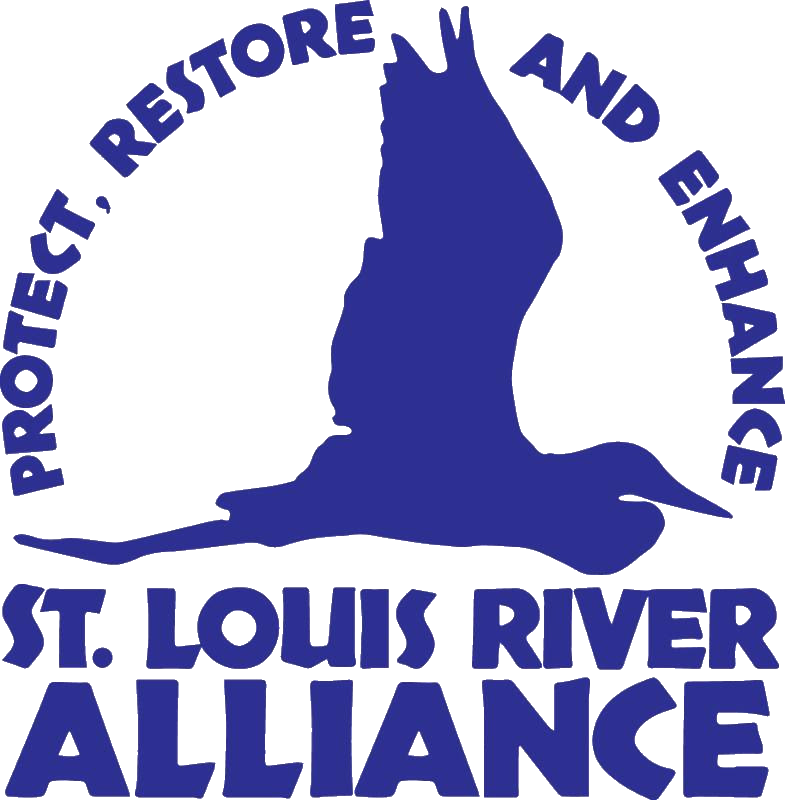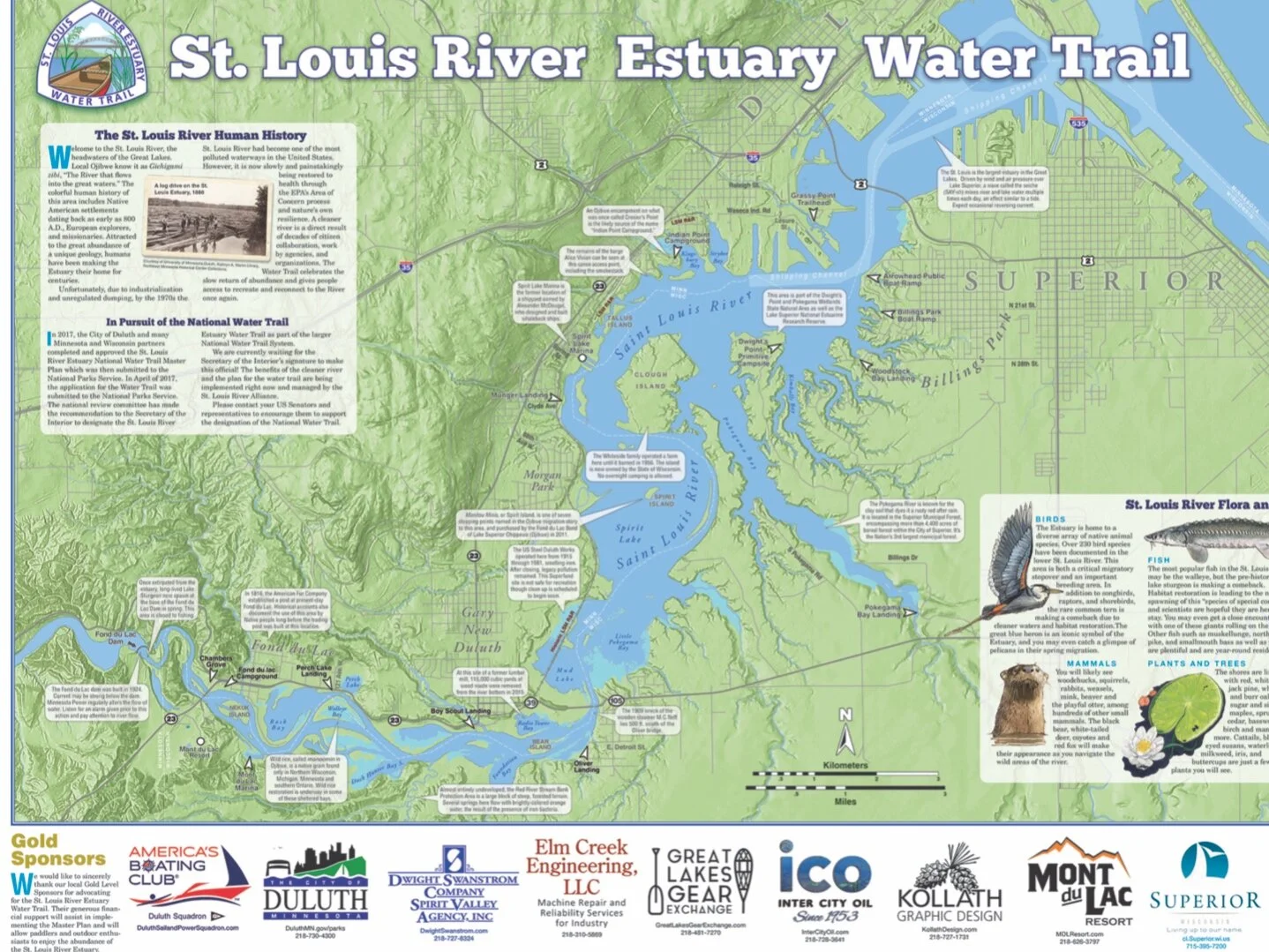St. Louis River Estuary National Water Trail
Unfortunately, due to unregulated industrial dumping, the St. Louis River was once one of the most polluted waterways in the United States. Though after decades of work the River is slowly returning to health. The St. Louis River Estuary National Water Trail project is a direct result of a cleaner river, and the St. Louis River Alliance has been an integral leader in the process!
Support the Water Trail, a cleaner river, and a healthier future for generations to come - become a member today!

National Water Trail Map
The St. Louis River Estuary *National Water Trail is a multi-use waterway enabling the public to experience the St. Louis River Estuary amidst the urban landscape of the Twin Ports. The Water Trail map includes 11 loop trails for paddlers of all skill levels and abilities and is intended for various watercraft use.
By providing access to wild space in an urban area, the Water trail enables more people an opportunity to build their own memories and relationships to the St. Louis River.
Share your pictures and experiences on social media with the hashtag #SLREWaterTrail
Map Distribution
Maps are FREE to the public and available for pick up at the St. Louis River Alliance office.
Dewitt Seitz Building at 394 S. Lake Avenue | Suite 208, Duluth, MN.
Building hours are Mon-Sat. 10-8 p.m., Sundays 10-5 p.m.
Contact free pick up
PDF Versions
We have created a PDF version of the map, split into sections, for your convenience. Maps are free and we encourage you to share them on your social platforms!
There are four main panels (A-D) with detailed route information. In addition, there is a large, full scale map highlighting history and River information. Please read through the entire map for safety guidelines and proper trail etiquette.
Sponsors
We would like to sincerely thank our local Gold and Silver Level Sponsors for advocating for the St. Louis River Estuary National Water Trail.
Their generous financial support will assist in implementing the Master Plan and will allow paddlers and outdoor enthusiasts to enjoy the abundance of the St. Louis River Estuary. Thank you Sponsors for helping make this map a reality!

History of the St. Louis River Estuary National Water Trail
The St. Louis River Alliance is the official manager and leader in implementing the St. Louis River Estuary National Water Trail Master Plan. In March of 2017, the City of Duluth and many Minnesota and Wisconsin partners completed and approved this plan. The Master Plan was then submitted to the National Parks Service. In April of 2017, the application for the Water Trail was submitted to the National Parks Service. The national review committee has made the recommendation to the Secretary of the Interior to designate the St. Louis River Estuary Water Trail as part of the larger National Water Trail System. We are currently waiting for the Secretary of the Interior’s signature to make this official! The benefits of the cleaner river and the plan for the water trail are being implemented right now and managed by the St. Louis River Alliance.
Benefits of a National Water Trail
Allow surrounding communities to engage both local citizens and visitors to return to the river and learn about its past, present and future
Positive economic impact from increased tourism
Assistance with stewardship & sustainability projects
Positive contributions to public healthy and quality of life from the restoration and maintenance of watershed resources
Increased awareness and promotion of the variety of year-round recreation opportunities along the St. Louis River estuary
Improve recreational accessibility to all regardless of skill level, ability or financial means

Water Trail Resources
We hope you enjoy the beautiful St. Louis River Estuary, but advise all paddlers to review the resources below to ensure a safe trip on the water!
Safety & Guidelines
Whether you are new to paddling or have been at it for a while, you owe it to yourself to make sure you are aware of the appropriate level of safety for the activity and conditions you are participating in.
The St. Louis River Estuary is an outdoor enthusiasts playground, and though we all want to have fun on the water, it is important to stay safe.
Here are 10 general guidelines to keep you prepared and secure while in the Estuary.
Float Plan
If you plan on paddling for just a few hours, let someone know where you expect to be and when you expect to return. If you plan a longer excursion, leave a copy of a written float plan with a friend, colleague, or family member.
A float plan provides a record for incase you do not return within reasonable time after your scheduled arrival. Print and Complete the Float Plan (pdf) and be sure to communicate your plans with at least one other person.
Trespassing
The St. Louis River Estuary National Water Trail is a great resource for the community. However, paddlers must be aware of trespass laws and should stay off anyone’s private property unless they are facing an emergency, are lost or require assistance.
Some exceptions:
The defendant is faced with an imminent threat of danger to themselves or another person
There are no practical or legal alternatives to resolve the situation at hand
The defendant acted out of necessity at all times

St. Louis River Flora & Fauna
The Estuary is home to a diverse array of native animal species.
Below are a list of some of the common birds, mammals, fish, plants & trees you could see while on the St. Louis River Estuary Water Trail.
Birds
Over 230 bird species have been documented in the lower St. Louis River. This area is both a critical migratory stopover and an important breeding area. In addition to songbirds, raptors, and shorebirds, the rare common tern is making a comeback due to cleaner waters and habitat restoration. You may even catch a glimpse of pelicans in their spring migration!
Mammals
You will likely see woodchucks, squirrels, rabbits, weasels, mink, beaver and the playful otter, among hundreds of other small mammals. The black bear, white-tailed deer, coyotes and red fox will make their appearance as you navigate the wild areas of the river.
Fish
The most popular fish in the St. Louis River may be the walleye, but the pre-historic sturgeon is making a comeback. Habitat restoration is leading to the natural spawning of this endangered species and scientists are hopeful they are here to stay. You may even get a close encounter with one of these giants rolling on the water! Other fish such as muskellunge, northern pike, and smallmouth bass as well as panfish are plentiful and are year-round residents.
Plants & Trees
The shores are lined with red, white, and jack pine, white and burr oak, sugar and silver maples, spruce, cedar, basswood, birch and many more. Cattails, black-eyed susans, waterlilies, milkweed, iris, and buttercups are just a few of the plants you will see.
Perhaps the most important plant in the Estuary is manoomin (wild rice). Manoomin is a water quality indicator and provides important habitat for fish and wildlife. Help protect this precious resource by learning about our restoration efforts & the SLRA Wild Rice Project!










